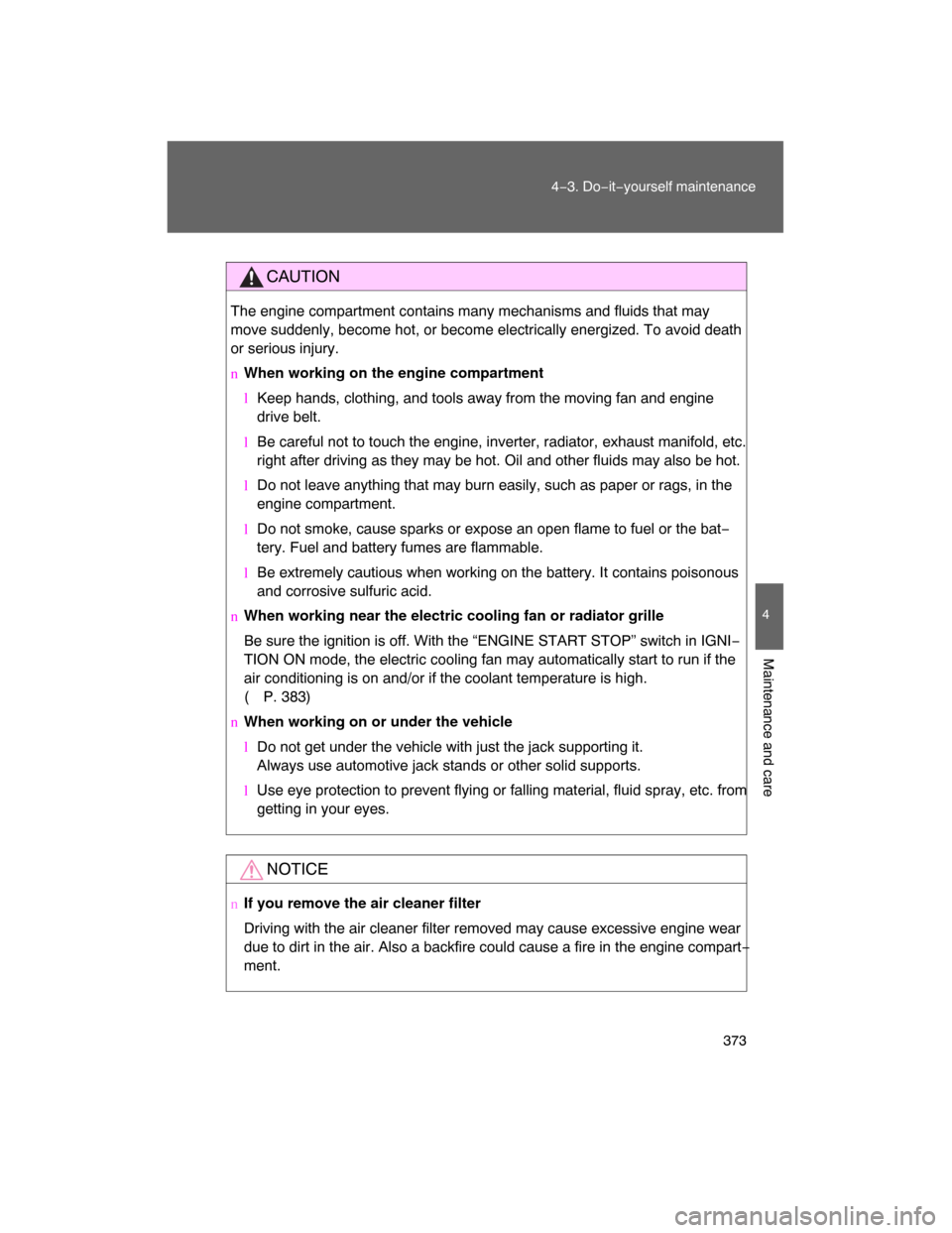Page 216 of 531

218 2−5. Driving information
CAUTION
n Things that must not be carried in the luggage compartment
The following things may cause a fire if loaded in the luggage compart−
ment.
lReceptacles containing gasoline
lAerosol cans
n Storage precautions
lDo not stack anything in the luggage compartment higher than the
seatbacks.
Such items may be thrown about and possibly injure people in the
vehicle during sudden braking or in an accident.
lDo not place cargo or luggage in or on the following locations as the
item may get under the brake or accelerator pedal and prevent the
pedals from being depressed properly
, block the driver ’s vision, or hit
the driver or passengers, causing an accident.
�Feet of the driver
�Front passenger or rear seats (when stacking items)
�Instrument panel
�Dashboard
�Auxiliary box or tray that has no lid
lSecure all items in the occupant compartment, as they may shift and
injure someone during an accident or sudden braking.
lNever allow anyone to ride in the luggage compartment. It is not
designed for passengers. They should ride in their seats with their seat
belts properly fastened. Otherwise, th
ey are much more likely to suffer
death or serious injury, in the event of sudden braking or a collision.
Page 358 of 531

363
4−1. Maintenance and care
4
Maintenance and care
nCleaning the inside of the rear window
Do not use glass cleaner to clean the rear window, as this may cause dam−
age to the rear window defogger heater wires. Use a cloth dampened with
lukewarm water to gently wipe the window clean. Wipe the window in
strokes running parallel to the heater wires or antenna.
nCaring for leather areas
Toyota recommends cleaning the interior of the vehicle at least twice a year
to maintain the quality of the vehicle’s interior.
nShampooing the carpets
There are several commercial foaming−type cleaners available. Use a
sponge or brush to apply the foam. Rub in overlapping circles. Do not apply
water. The excellent results are obtained by keeping the carpet as dry as
possible.
nSeat belts
Clean with mild soap and lukewarm water using a cloth or sponge. Also
check the belts periodically for excessive wear, fraying or cuts.
CAUTION
nWater in the vehicle
lBe careful not to splash or spill liquid on the floor.
lDo not get any of the SRS components or wiring in the vehicle interior wet.
( P. 104)
Electrical malfunction may cause the airbags to deploy or not function
properly, resulting in death or serious injury.
Page 363 of 531
368 4−2. Maintenance
Vehicle interior
Items Check points
Accelerator pedal�Moves smoothly (without uneven
pedal effort or catching)?
Automatic transmission “Park”
mechanism�Can the vehicle be hold securely
on an incline with the shift lever in
“P”?
Brake pedal�Moves smoothly?
�Does it have appropriate clear−
ance and correct amount of free
play?
Brakes�Pulls to one side when applied?
�Loss of brake effectiveness?
�Spongy feeling brake pedal?
�Pedal almost touches floor?
Head restraints�Move smoothly and lock
securely?
Indicators/buzzers�Function properly?
Lights�Do all the lights come on?
�Headlights aimed correctly?
Parking brake�Moves smoothly?
�Can hold the vehicle securely on
an incline?
Seat belts�Does the seat belt system oper−
ate smoothly?
�Are the belts undamaged?
Seats�Do the seat controls operate
properly?
Steering wheel
�Moves smoothly?
�Has correct free play?
�No strange noises?
Page 368 of 531

373
4−3. Do−it−yourself maintenance
4
Maintenance and care
CAUTION
The engine compartment contains many mechanisms and fluids that may
move suddenly, become hot, or become electrically energized. To avoid death
or serious injury.
nWhen working on the engine compartment
lKeep hands, clothing, and tools away from the moving fan and engine
drive belt.
lBe careful not to touch the engine, inverter, radiator, exhaust manifold, etc.
right after driving as they may be hot. Oil and other fluids may also be hot.
lDo not leave anything that may burn easily, such as paper or rags, in the
engine compartment.
lDo not smoke, cause sparks or expose an open flame to fuel or the bat−
tery. Fuel and battery fumes are flammable.
lBe extremely cautious when working on the battery. It contains poisonous
and corrosive sulfuric acid.
nWhen working near the electric cooling fan or radiator grille
Be sure the ignition is off. With the “ENGINE START STOP” switch in IGNI−
TION ON mode, the electric cooling fan may automatically start to run if the
air conditioning is on and/or if the coolant temperature is high.
(P. 383)
nWhen working on or under the vehicle
lDo not get under the vehicle with just the jack supporting it.
Always use automotive jack stands or other solid supports.
lUse eye protection to prevent flying or falling material, fluid spray, etc. from
getting in your eyes.
NOTICE
nIf you remove the air cleaner filter
Driving with the air cleaner filter removed may cause excessive engine wear
due to dirt in the air. Also a backfire could cause a fire in the engine compart−
ment.
Page 394 of 531

399
4−3. Do−it−yourself maintenance
4
Maintenance and care
CAUTION
n Tire pressure warning system operation
The tire pressure warning system may not provide warning immediately
if a tire bursts or if
sudden air leakage occurs.
n When inspecting or replacing tires
Observe the following precautions to prevent accidents. Failure to do so
may cause damage to parts of the drive train, as well as dangerous han−
dling characteristics, which may le
ad to fatal or injury accidents.
lDo not mix tires of different makes, models, tread patterns or tread−
wear.
lDo not use tire sizes other than those recommended by Toyota.
lDo not mix radial, bias−belted, or bias−ply tires.
lDo not mix summer, all season and winter tires.
lDo not use tire that have been used on another vehicle.
Do not use tires if you do not know they were used previously.
n When initializing the tire pressure warning system
Do not press the tire pressure warning reset switch without first adjusting
the tire inflation pressure to the spec
ified level. Otherwise, the tire pres−
sure warning light may not come on ev en if the tire inflation pressure is
low, or it may come on when the tire
inflation pressure is actually normal.
NOTICE
n Repairing or replacing tires, wheels and tire pressure warning
valves and transmitters
When removing or fitting the wheels, tires or the tire pressure warning
valve and transmitter, contact your Toyota dealer as the tire pressure
warning valve and transmitter may be damaged if not handled correctly.
n To avoid damaging the tire pressure warning valves and transmit�
ters
Do not use liquid sealants on flat tires.
Page 417 of 531

422 4−3. Do−it−yourself maintenance
5 ECU−IG NO.2 10 AAir conditioning system,
heater, overhead module,
ABS, VSC, steering sensor,
yaw rate & G sensor, main
body ECU, stoplights, moon
roof, clock, EC mirror
6 WINCH 5 A No circuit
7 A/C IG 10 ACool box, condenser fan,
cooler compressor, MG CL,
rear window defogger, RR
MGC VLV
8 TA I L 15 ATail lights, license plate lights,
front fog lights, front side
marker lights, rear side marker
lights, parking lights
9 WIPER 30 A Windshield wiper
10 WSH 20 A Windshield washer
11 RR WIPER 15 A Rear wiper
12 4WD 20 A 4WD
13 LH−IG 5 AAlternator, sub battery, seat
heater, windshield wiper de−
icer, seat belt pretensioners,
emergency flasher, inverter,
shift lever switch
14 ECU−IG NO.1 5 AABS, VSC, tilt and telescopic
steering, gateway ECU, shift
lock system, cruise control sys−
tem, pre−collision seat belt,
headlight cleaner, multi−dis−
play assembly, driving position
memory system, power door
lock system
15 S/ROOF
25 A Moon roof
FuseAmpereCircuit
Page 418 of 531
423
4−3. Do−it−yourself maintenance
4
Maintenance and care
16 RR DOOR RH 20 A Power windows
17 MIR 15 AMirror ECU, outside rear view
mirror heater
18 RR DOOR LH 20 A Power windows
19 FR DOOR LH 20 A Power windows
20 FR DOOR RH 20 A Power windows
21 RR FOG 7.5 A No circuit
22 A/C 7.5 A Air conditioning system
23 AM1 5 A No circuit
24 TI & TE 15 A Tilt and telescopic steering
25 FR P/SEAT RH 30 A Front seat adjustment
26 PWR OUTLET 15 A Power outlet
27 OBD 7.5 A DLC3
28 PSB 30 A Pre−collision seat belt
29 DOOR NO.1 25 A Main body ECU
30 FR P/SEAT LH 30 A Front seat adjustment
31 INVERTER
15 A Inverter
FuseAmpereCircuit
Page 441 of 531

5
When trouble arises
447
5−1. Essential information
Event data recorder
In a crash or a near car crash event
The SRS airbag sensor assembly contains the EDR. In a crash or a
near car crash event, this device may record some or all of the follow−
ing information:
lEngine speed
l
Whether the brake pedal was applied or not
lVehicle speed
l
To what extent the accelerator pedal was depressed
l
Position of the transmission shift lever
lWhether the driver and front passenger wore seat belts or not
l
Driver ’s seat position
l
Front passenger ’s occupant classification
lSRS airbag deployment data
l
SRS airbag system diagnostic data
The information above is intended
to be used for the purpose of
improving vehicle safety performance. Unlike general data recorders,
the EDR does not record sound data such as conversation between
passengers.
Your vehicle has computers that monitor and control certain aspects
of your vehicle. These computers assi
st in driving and maintaining
optimal vehicle performance.
Besides storing data useful for tr oubleshooting, there is a system to
record data in a crash or a near
car crash event. This is called an
Event Data Recorder (EDR).